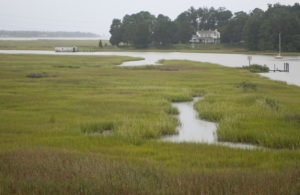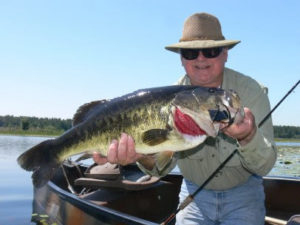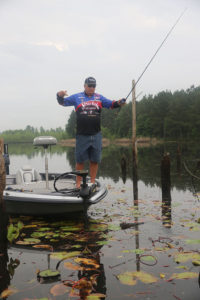August Bass at Lake Juliette
Ready for an August bass fishing trip where you can fish, not bounce around from wakes of off-shore ski boats and yachts? Where the sound of skidoos never irritate your ears? Want to fish a lake full of big bass, where five pounders are brought in regularly and ten pounders are not unusual? Then plan a trip to Lake Juliette.
Located about 15 miles east of I-75 near Forsyth, Juliette is a 3000 acre Georgia Power lake. It is on Rum Creek but that creek is so small water is pumped in from the nearby Ocmulgee River to keep the lake full. Since there is almost no run-off, the lake is extremely clear for middle Georgia.
Clear water means lots of underwater plant growth. Grass grows thick in most parts of Juliette and breaks the surface from ten feet down in many places. In early July there was a distinct grass line 21 feet deep in most of the lake, with a 2 to 3 foot line of grass growing that deep. Bass love that grass.
You are restricted to a maximum 25 horsepower motor on your boat, so you will need a smaller boat to get around. In August a depthfinder is invaluable and you need one that will clearly show the grass. You can put in your bass boat and use the trolling motor but Juliette is big enough that you can not fish much of it that way.
Two ramps give good access to Juliette. Dames Ferry near the dam has a double paved ramp, picnic area and campground. Holly Grove on the upper end of the lake does not have any camping. The upper end of the lake if full of standing timber at and just under the surface, and you must follow the channel to avoid stumps and trees. Since you are restricted in the size of your motor, choose the ramp closest to where you want to fish.
Kevin Whidby grew up fishing Lake Juliette. He lives in nearby Gray and started fishing the lake with his father and uncle as soon as it was opened. He has been fishing the monthly tournament there most months for the past 15 years, first with his father and uncle, then out of his own boat a few years ago.
Over the years Kevin has done well in the tournaments. His biggest bass ever out of Juliette is a 10 pound 11 ounce monster, and he caught a 10 pound 6 ounce hog in a tournament there. It was not big fish that day, another fisherman had one a few ounces heavier.
In the June tournament Kevin came in second place with four bass weighing 9 pounds 12 ounces and had one bass weighing right at 5 pounds. There were two other 5 pounders brought in that day by 21 teams. A few days later when he and I fished the lake for a few hours after work, he landed a 4.25 pound bass on a spinnerbait and I landed one around 3.5 pounds on a Texas rigged Mag 2 worm. Bass that size are caught on most trips.
Kevin keys on the grass in August. He looks for a shallow hump or long point near deep water where the grass on top comes to the surface. Early in the morning and on cloudy days he says the bass move up in this shallow grass to feed. He will throw a topwater plug, Trick worm and Fluke, and a spinnerbait to these shallow feeding fish.
As the sun gets up the bass back out into the deeper grass. Then is when Kevin rides with his depthfinder looking for bass holding along the grass edge. He is also looking for baitfish since the bass will not be far from them. When he finds bass holding near the bottom he will cast a Carolina rigged Finesse worm, Trick worm or lizard to them.
Since the bigger bass tend to suspend off the bottom, Kevin likes to use a light 1/4 ounce lead on his Carolina rig and a two foot leader. The lighter lead allows the bait to fall more slowly and give suspended bass a chance to hit it. It also comes through the grass better.
Since the bass tend to hold right on the edge of the grass, Kevin will start by getting his boat over the shallow part of the structure and casting out into deeper water. Bringing the bait to the grass edge works best if the bass are concentrated. If they are scattered, he tries to hold his boat right on the grass edge and make parallel casts to it, covering as much of it as possible on each cast.
When the bass are suspended off the bottom and won’t hit the falling Carolina rig, Kevin will make a long cast with a spinnerbait and allow it to fall to them before making a slow retrieve, keeping it at their level as long as possible.
Bass will position on different parts of the structure and may move every day. Some days they will be on the steep drop side, others they seem to favor the more sloping side of the structure. There is so much grass on all the bottom that they can find the edge on whatever kind of bottom they want.
The following ten spots are all good in August and Kevin fishes them. They will give you an idea of the kinds of structure you should fish at Juliette this time of year. There are lots more similar places on the lake to discover, too.
1. N 33 02.908 – W 83 46.199 – If you put in at Dames Ferry Ramp, come out of the cove to the main lake and head upstream toward the power plant. The first long point on your right runs way out and continues underwater. The upstream side drops off fast and the downstream side slopes into a flat on the cove side, offering bass different kinds of bottom contour. Both sides have lots of grass on them.
Start by keeping your boat out in deeper water and casting topwater, soft jerkbaits or a spinnerbait across the shallow grass. Work all the way around the point with these baits, covering all the grass from different angles. When your spinnerbait hits a clump of grass, jerk it free and continue the retrieve. Bass will often hit when the bait jumps forward after being pulled free.
Watch your depthfinder as you fish around this point, and then ride it after casting to it. Go over the edge of the grass looking for bass near the bottom. If you find a concentration, move up on top of the point and cast out past them to the clean bottom. Work your Carolina rig up to them and then into the edge of the grass for any holding there.
If the bass are scattered, get out and cast parallel to the drop in the grass, keeping your bait as close to the grass as possible. Also cast a spinnerbait and let it sink almost to the bottom, then slow roll it back for suspended bass.
2. N 32 02.377 – W 83 46.016 – The big cove upstream of you has a point in the middle with a visible roadbed running off it. The point is marked “Quail Head” on some maps. The road bed comes out into the cove and turns toward the downstream point you just fished. There is a shallow spot out in the middle of the cove on the roadbed, too.
Keep your boat off the road and cast to the grass on top of it. Watch for visible grass sticking out of the water, sometimes it is just visible, depending on the water level. Fish it all the way across then come back with your boat shallow, casting out to the edge of the grass and fishing it from shallow to deep.
On this spot as others you can find a 3 to 4 foot tall wall of grass down around 21 feet deep. This wall is where the bass hold. Keep your depthfinder on and learn how the grass grows to help you find the bass.
3. N 33 02.047 – N 83 46.254 – Run across to the opposite side of the lake, the left side running upstream away from the dam. You will see some big rocks on a island near the dam, Taylor’s Island on some maps, and you want to fish the second main lake point upstream of it. There is a small pole out on the point on the downstream side that will help you identify it.
Idle in toward this point slowly since it runs way out in a big flat. On the downstream side of the point there is a good drop on the channel side and a good grass line on the drop to fish. Fish it like the other spots, fishing shallow first then working out to the deeper fish.
4. N 32 02.373 – W 83 46.346 – Back across the lake just off the upstream point of Quail’s Head, a hump comes up shallow about 100 yards off the bank. The point on the bank is clay and white rock and the hump comes up to about 8 feet deep when the lake is full. Grass grows on it and bass hold there all summer long.
Watch out when looking for it, there are two big rocks on it that will eat a lower unit if the water is down any at all. You should be able to see the grass sticking out of the water on this hump and the bottom color will show if the sun is out.
5. N 33 02.675 – W 83 46.943 – Head on upstream and you will see a small island on the left with a long point running out across the channel. The island is just downstream of Persons Point and the shallow point runs way out off the bank. There is a small patch of standing timber in the cove upstream of the point and a small pole on the point to help identify it.
Kevin says he likes to start way out on the point out near the channel and work up it toward the bank. Bass will hold on both sides of this point as well as out in the deeper water on the end. Check it all out, and don’t forget to cast across the shallow grass with your spinnerbait and topwater baits.
6. N 33 03.234 – W 83 47.215 – Straight across the lake are two big bays. The one on the left headed in is Buzzards Bay and it has some white box-looking structures in it. You want to go into the cove to the right of it. There is a point running across this cove and you will be almost on top of it when the box structures disappear behind the trees on the point between the two bays.
Wind often blows into this cove and that makes it even better. Wind will make the bass move up more shallow to feed, and position them on the windy side. Stay out from the point and cast across it first, especially it the wind is blowing across the point. Then get up on the point and cast out toward the lake, into the wind, and bring your bait back to the grass edge with the wind.
7. N 33 02.695 – W 83 48.404 – Back across the lake, directly across from the power plant, a rocky point runs out and drops off, then comes back up into a rocky hump a few feet off the bank. The bare rocks are visible off the point, but there are many others underwater. This point and hump are right at the mouth of the first creek with standing timber.
The timber, rocks and two creek channels make this an excellent place to find August bass. Fish all around the point working the rocks and grass on it from all angles. Bass will hold on either side of the point so check it all out.
8. N 33 02.801 – W 83 48.542 – The upstream point on the right going up, the one on the cove for the power plant, holds a lot of bass this time of year. It is deep on both sides but comes up real shallow. The main lake point is excellent and the smaller secondary point going into the power plant cove also holds fish. There is a flat between them with grass on it.
Fish both points and the flat shallow first. Then work around the two points and the outside edge of the flat, fishing the grass line off them. This is right where the timber starts on this side so bass have a variety of places to hold, and can run in and out of the timber to feed.
9. N 33 03.066 – W 83 49.397 – Head up past the Settling Pond Dam but go slow, there is a lot of timber in this area. The point on the upstream side of the cove with the settling pond dam in it runs out to the middle of the cove and there is an old duck blind on it. This point runs way out into the timber and is very shallow.
Fish the point all the way to the end and watch toward the channel. You will see a hump coming up that breaks the surface if the water is down any. You can see the red colored bottom if the lake is up and there is a big stump on it. Work around this hump like you fished the point running out to it.
10 N 33 03.029 – W 83 49.928 – Ease out to the channel and head upstream to the roadbed crossing just upstream of a point. You can see it well defined on the right and can see where it comes out on the left bank, too. Fish the drops on both sides of the roadbed as well as the point where it comes out of the water.
Kevin told me he has caught two bass over eight pounds each off this roadbed. Fish it with a spinnerbait down deep as well as a Carolina rig. You can cast across it, working both sides, or sit on one lip and cast parallel to the drop, working one side then moving to the other.
Kevin catches a lot of bass off these ten spots, and there are many others similar to them. You can discover some by studying a good map, but to really learn the lake you have to do like Kevin, get out there in a boat with a good depthfinder and ride the lake. It will pay off in quality bass this August.
The tournament at Juliette is the last Sunday each month out of Dames Ferry. Their end of year tournament is in October and the trail starts over in November, so now it a great time to learn the lake and start fishing the tournaments in a couple of months.
Entry fee is $50 per team and that includes a $5 big fish pot. Payback is one place if five boats enter up to three places if enough boats enter, and $10 per boat is held back for the year end Classic, which is the top 15 boats from the year, by weight.
They fish from daylight to 3:00 PM and you can show up at the ramp 30 minutes before daylight to enter, or call Greg for more info at 478-471-1254.


